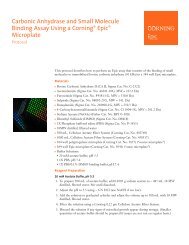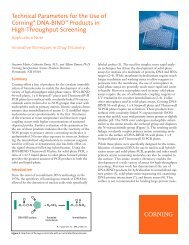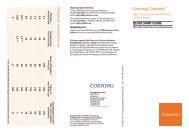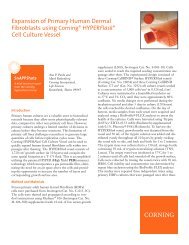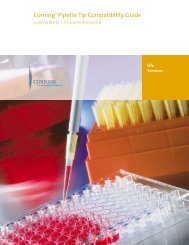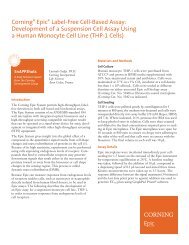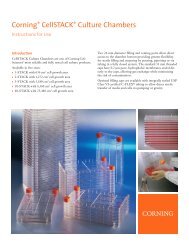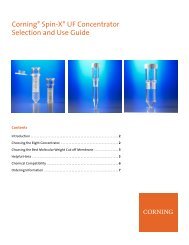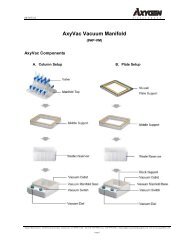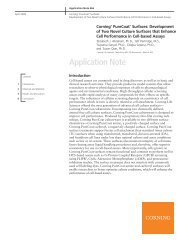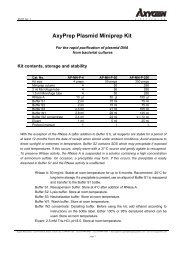AxyPrep Multisource Genomic DNA Miniprep Kit
AxyPrep Multisource Genomic DNA Miniprep Kit
AxyPrep Multisource Genomic DNA Miniprep Kit
You also want an ePaper? Increase the reach of your titles
YUMPU automatically turns print PDFs into web optimized ePapers that Google loves.
09/02 Ver. 1<br />
<strong>AxyPrep</strong> <strong>Multisource</strong> <strong>Genomic</strong> <strong>DNA</strong> <strong>Miniprep</strong> <strong>Kit</strong><br />
For the purification of genomic <strong>DNA</strong> from animal tissues, plant tissues, filamentous<br />
fungi, cultured cells, lymphocytes, bone marrow, bone, buccal swabs and yeast<br />
<strong>Kit</strong> contents, storage and stability<br />
Cat. No. AP-MN-MS-G<strong>DNA</strong>-4 AP-MN- MS-G<strong>DNA</strong>-50<br />
<strong>Kit</strong> size 4 preps 50 preps<br />
<strong>Miniprep</strong> column 4 50<br />
1.5 ml microfuge tube 4 50<br />
2 ml microfuge tube 8 100<br />
RNase A 10 µl 60 µl<br />
Buffer C-L 1 ml 9 ml<br />
Proteinase K 1.2 mg 18 mg<br />
PK Buffer 90 µl 1.2 ml<br />
Buffer P-D 2 ml 25 ml<br />
Buffer W1 3 ml 30 ml<br />
Buffer W2 concentrate 2.4 ml 24 ml<br />
Eluent 1 ml 12 ml<br />
Protocol manual 1 1<br />
Except for the RNase A and Proteinase K, all buffers are stable for a period of at least 12 months<br />
from the date of receipt when stored under ambient conditions. Please avoid exposure to direct<br />
sunlight or extremes in temperature. After reconstitution, Proteinase K is stable for 2 months when<br />
stored at 4°C. To preserve RNase A activity, the RNase A is suspended in a solution containing a<br />
high concentration of ammonium sulfate. The lyophilized Proteinase K is resuspended in PK Buffer,<br />
which also contains ammonium sulfate. On occasion, a precipitate may form. If this occurs,<br />
resuspend by vortexing or pipetting before use. Enzymatic activity is unaffected by the formation of<br />
a precipitate.<br />
RNase A: 50 mg/ml. Store at room temperature.<br />
Buffer C-L: Lysis buffer. Store at room temperature.<br />
Proteinase K: Lyophilized Proteinase K is stable for up to 6 months after delivery when<br />
stored at room temperature. After reconstitution with PK Buffer, Proteinase K is<br />
stable for 2 months when stored at 4°C. Storing the Proteinase K stock solution<br />
at room temperature for prolonged periods of time should be avoided.<br />
PK Buffer: Used to resuspend Proteinase K. Store at room temperature.<br />
Buffer P-D: Protein precipitation buffer. Store at room temperature.<br />
Buffer W1: Wash buffer. Store at room temperature.<br />
Axygen Biosciences 33210 Central Avenue, Union City, CA 94587 USA Tel:510-494-8900 Fax:510-494-0700 e-mail:support.axyprepkits@axygenbio.com<br />
web:www.axygenbio.com<br />
page 1
09/02 Ver. 1<br />
Buffer W2 concentrate: Desalting buffer. Before using the kit, add the amount of ethanol<br />
specified on the bottle label to the Buffer W2 concentrate. Either 100% or 95%<br />
denatured ethanol can be used. Store at room temperature.<br />
Eluent: 2.5 mM Tris-HCl, pH 8.5. Store at room temperature.<br />
Introduction<br />
The <strong>AxyPrep</strong> <strong>Multisource</strong> <strong>Genomic</strong> <strong>DNA</strong> <strong>Miniprep</strong> <strong>Kit</strong> is designed to purify genomic <strong>DNA</strong> from a<br />
wide variety of different starting materials. This system employs a special lysis Buffer C-L and<br />
Proteinase K, to efficiently release genomic <strong>DNA</strong> from the biologic starting materials. Contaminating<br />
proteins, pigments, carbohydrates and lipids are then efficiently segregated from the genomic <strong>DNA</strong><br />
by precipitation with Buffer P-D, coupled with the selective adsorption of the genomic <strong>DNA</strong> to a<br />
special <strong>AxyPrep</strong> column. After washing and desalting, the purified <strong>DNA</strong> is then eluted in either a<br />
Tris buffer or deionized water. <strong>Genomic</strong> <strong>DNA</strong> prepared by this method is approximately 30 Kb in<br />
length and is suitable for a variety of applications, such as PCR amplification, Southern blot analysis,<br />
etc. Each <strong>AxyPrep</strong> column will bind and purify up to 20 μg of genomic <strong>DNA</strong>.<br />
For the purification of genomic <strong>DNA</strong> from whole blood, we recommend the <strong>AxyPrep</strong> Blood <strong>Genomic</strong><br />
<strong>DNA</strong> <strong>Kit</strong>s: Mini (#AP-MN-BL-G<strong>DNA</strong>-4/50/250); Midi (#AP-MD-BL-G<strong>DNA</strong>-2/10/25); Maxi (#AP-MX-<br />
BL-G<strong>DNA</strong>-2/10/25). For the purification of bacterial genomic <strong>DNA</strong>, please refer to the <strong>AxyPrep</strong><br />
Bacterial <strong>Genomic</strong> <strong>DNA</strong> <strong>Miniprep</strong> <strong>Kit</strong> (#AP-MN-BT-G<strong>DNA</strong>-4/50/250).<br />
Caution<br />
Buffer C-L, Buffer P-D and Buffer W1 contain chemical irritants. When working with these buffers,<br />
always wear suitable protection such as safety glasses, laboratory coat and gloves. Be careful to<br />
avoid contact with eyes and skin. In the case of such contact, wash immediately with water. If<br />
necessary, seek medical assistance.<br />
Equipment and consumables required<br />
• Microcentrifuge capable of 12,000xg<br />
• Mortar and pestle<br />
• Heated water bath<br />
• AxyVac Vacuum manifold (#AP-VM)<br />
• Vacuum regulator<br />
• Vacuum source (-25-30 inches Hg required)<br />
• 100% or 95% (denatured) ethanol<br />
Preparation before experiment<br />
1) Reconstitution of Buffer W2. Before using the kit, add the amount of ethanol specified on the Buffer<br />
W2 label and mix well. Either 100% or 95% (denatured) ethanol can be used.<br />
2) Adjust a water bath to 56°C.<br />
Axygen Biosciences 33210 Central Avenue, Union City, CA 94587 USA Tel:510-494-8900 Fax:510-494-0700 e-mail:support.axyprepkits@axygenbio.com<br />
web:www.axygenbio.com<br />
page 2
09/02 Ver. 1<br />
3) Check Buffer C-L and Buffer P-D for precipitation before each use. If precipitation occurs, incubate<br />
at 37°C to dissolve the precipitate.<br />
4) Pre-warming the Eluent to 65°C will often improve elution efficiency.<br />
5) Resuspend Proteinase K in PK Buffer.<br />
6) Prepare phosphate-buffered saline (PBS). Dissolve in 800 ml of distilled H 2 O: 8 g of NaCl, 0.2 g of<br />
KCl, 1.44 g of Na 2 HPO 4 and 0.24 g of KH 2 PO 4 . Adjust the pH to 7.4 with HCl. Add H 2 O to 1 liter.<br />
Protocols<br />
I. Purification of <strong>Genomic</strong> <strong>DNA</strong> from Animal Tissues<br />
II. Purification of <strong>Genomic</strong> <strong>DNA</strong> from Plant Tissues and Filamentous Fungi<br />
III. Purification of <strong>Genomic</strong> <strong>DNA</strong> from Cultured Cells, Lymphocytes, Bone Marrow and Bone<br />
IV. Purification of <strong>Genomic</strong> <strong>DNA</strong> from Buccal Swabs<br />
V. Purification of <strong>Genomic</strong> <strong>DNA</strong> from Yeast<br />
Each type of starting materials has different requirements for the method(s) used to achieve efficient<br />
lysis and homogenization. Both vacuum and centrifuge protocols are provided for each starting<br />
material type.<br />
I. Purification of <strong>Genomic</strong> <strong>DNA</strong> from Animal Tissues<br />
[Vacuum protocol]<br />
This procedure requires use of the AxyVac vacuum manifold or other manifold with complementary<br />
luer fittings, which can accommodate the <strong>Miniprep</strong> columns. The use of a vacuum regulator is<br />
also recommended. A negative pressure of –25-30 inches Hg is required. This is equivalent to<br />
approximately -850-1,000 mbar and -12-15 psi.<br />
Lysis and homogenization using a mortar and pestle<br />
1. Select 1-20 mg of animal tissue and transfer to a mortar, pre-chilled on ice. Grind rapidly and<br />
vigorously to form a homogenate.<br />
Note: the following tissue-types should be completely frozen in liquid nitrogen before grinding:<br />
• DNase-rich tissues, such as pancreas, thymus, lymphoid tissue, etc.<br />
• Collagen-rich tissues, such as skin, connective tissue, etc.<br />
• Keratoprotein-rich tissues or hard tissues, such as bone.<br />
2. Add 350 µl of phosphate-buffered saline (PBS, not provided) and 0.9 µl of RNase A. Gently<br />
grind for 30 seconds to homogenously mix the PBS with the ground tissue.<br />
Note: For those tissue types in Step 1 (above) that require freezing in liquid nitrogen, please perform the<br />
following steps after pulverizing: Add 350 µl of PBS and 0.9 µl of RNase A. Warm the mortar to 56°C in<br />
the water bath until the PBS just melts. Gently grind for 1 minute. Then proceed to Step 3, below.<br />
3. Collect 350 µl of the homogenate and transfer to a 2 ml microfuge tube (provided). If the<br />
volume of the homogenate is less than 350 µl, make it up to 350 µl with PBS.<br />
Axygen Biosciences 33210 Central Avenue, Union City, CA 94587 USA Tel:510-494-8900 Fax:510-494-0700 e-mail:support.axyprepkits@axygenbio.com<br />
web:www.axygenbio.com<br />
page 3
09/02 Ver. 1<br />
4. Add 20 µl Proteinase K and 150 µl Buffer C-L. Mix immediately by vortexing for 1 minute.<br />
Note: Do not add Proteinase K directly to buffer C-L.<br />
5. Incubate at 56°C for 15 minutes. Briefly centrifuge to remove drops from inside the lid.<br />
6. Add 350 µl Buffer P-D to the sample and mix by vortexing at top speed for 30 seconds.<br />
7. Centrifuge for 10 minutes at 12,000xg at ambient temperature to pellet cellular debris.<br />
Binding, washing and elution on the <strong>Miniprep</strong> column<br />
8. Attach the vacuum manifold base to a vacuum source. Firmly position the <strong>Miniprep</strong> column(s)<br />
into the complementary fittings on the manifold top. Transfer the clarified supernatant obtained<br />
from Step 7 to the <strong>Miniprep</strong> column. Turn on the vacuum source and adjust to -25 inches Hg.<br />
Continue to apply the vacuum until no solution remains in the <strong>Miniprep</strong> column.<br />
9. Add 500 µl of Buffer W1 and draw all of the solution through the column.<br />
10. Add 700 µl of Buffer W2 along the wall of <strong>Miniprep</strong> column to wash off residual Buffer W1 and<br />
draw all of the solution through the column. Repeat this wash step with a second 700 µl aliquot<br />
of Buffer W2.<br />
Note: Make sure that ethanol has been added into Buffer W2 concentrate.<br />
Note: Add Buffer W2 along the tube wall to wash off any residual salt.<br />
Note: Two washes with Buffer W2 are used to ensure the complete removal of salt, eliminating potential problems<br />
in subsequent enzymatic reactions.<br />
11. Transfer the <strong>Miniprep</strong> column to a 2 ml microfuge tube (provided) and centrifuge for 1 minute at<br />
12,000xg.<br />
12. Transfer the <strong>Miniprep</strong> column to a clean 1.5 ml microfuge tube (provided). To elute the genomic<br />
<strong>DNA</strong>, add 100-200 µl of Eluent (or deionized water) to the center of the membrane. Let it<br />
stand for 1 minute at room temperature. Centrifuge for 1 minute at 12,000xg.<br />
Note: Pre-warming water or Eluent at 65°C will often improve elution efficiency.<br />
[Centrifuge protocol]<br />
Lysis and homogenization using a mortar and pestle<br />
1. Select 1-20 mg of animal tissue and transfer to a mortar, pre-chilled on ice. Grind rapidly and<br />
vigorously to form a homogenate.<br />
Note: the following tissue-types should be completely frozen in liquid nitrogen before grinding:<br />
• DNase-rich tissues, such as pancreas, thymus, lymphoid tissue, etc.<br />
• Collagen-rich tissues, such as skin, connective tissue, etc.<br />
• Keratin-rich tissues or hard tissues, such as bone.<br />
2. Add 350 µl of PBS (not provided), and 0.9 µl of RNase A. Gently grind for 30 seconds to<br />
homogenously mix the PBS with the ground tissue.<br />
Note: For those tissue types in Step 1 (above) requiring freezing in liquid nitrogen, please perform the following<br />
steps after pulverizing: Add 350 µl of PBS and 0.9 µl of RNase A. Warm the mortar to 56°C in water bath<br />
until the PBS just melts. Gently grind for 1 minute. Then proceed to Step 3, below.<br />
Axygen Biosciences 33210 Central Avenue, Union City, CA 94587 USA Tel:510-494-8900 Fax:510-494-0700 e-mail:support.axyprepkits@axygenbio.com<br />
web:www.axygenbio.com<br />
page 4
09/02 Ver. 1<br />
3. Collect 350 µl of the homogenate and transfer to a 2 ml microfuge tube (provided). If the volume<br />
of the homogenate is less than 350 µl, make it up to 350 µl with PBS.<br />
4. Add 20 µl Proteinase K and 150 µl Buffer C-L. Mix immediately by vortexing for 1 minute.<br />
Note: Do not add Proteinase K directly to buffer C–L.<br />
5. Incubate at 56°C for 15 minutes. Briefly centrifuge to remove drops from inside the lid.<br />
6. Add 350 µl Buffer P-D to the sample and mix by vortexing at top speed for 30 seconds.<br />
7. Centrifuge at 12,000xg for 10 minutes at ambient temperature to pellet cellular debris.<br />
Binding, washing and elution on the <strong>Miniprep</strong> column<br />
8. Place a <strong>Miniprep</strong> column into a 2 ml microfuge tube (provided). Pipette the clarified supernatant<br />
obtained from step 7 into the <strong>Miniprep</strong> column. Centrifuge for 1 minute at 12,000xg.<br />
9. Discard the filtrate from the 2 ml microfuge tube. Place the <strong>Miniprep</strong> column back into the 2 ml<br />
microfuge tube. Pipette 500 µl of Buffer W1 to the <strong>Miniprep</strong> column and centrifuge at 12,000xg<br />
for 1 minute.<br />
10. Discard the filtrate and place the <strong>Miniprep</strong> column back into the 2 ml microfuge tube. Add 700 µl<br />
of Buffer W2 and centrifuge for 1 minute at 12,000xg. Discard the filtrate from the 2 ml microfuge<br />
tube and repeat this wash step with a second 700 µl aliquot of Buffer W2.<br />
Note: Make sure that ethanol has been added into Buffer W2 concentrate.<br />
Note: Two washes with Buffer W2 are used to ensure the complete removal of salt, eliminating potential<br />
problems in subsequent enzymatic reactions.<br />
11. Discard filtrate from the 2 ml microfuge tube. Place the <strong>Miniprep</strong> column back into the 2 ml<br />
microfuge tube and centrifuge for 1 minute at 12,000xg.<br />
12. Transfer the <strong>Miniprep</strong> column into a clean 1.5 ml microfuge tube (provided). To elute the<br />
genomic <strong>DNA</strong>, add 100-200 µl of Eluent (or deionized water) to the center of the membrane.<br />
Let it stand for 1 minute at room temperature. Centrifuge for 1 minute at 12,000xg.<br />
Note: Pre-warming water or Eluent at 65°C will often improve elution efficiency.<br />
II. Purification of <strong>Genomic</strong> <strong>DNA</strong> from Plant Tissues and Filamentous Fungi<br />
[Vacuum Protocol]<br />
This procedure requires the use of AxyVac vacuum manifold or other manifold with complementary<br />
luer fittings which can accommodate the <strong>Miniprep</strong> columns. The use of a vacuum regulator is also<br />
recommended. A negative pressure of –25-30 inches Hg is required. This is equivalent to<br />
approximately -850-1,000 mbar and -12-15 psi.<br />
Lysis and homogenization using a mortar and pestle<br />
1. Using Table 1 (below), weigh out the appropriate amount of either fresh plant tissue or<br />
filamentous fungi and transfer to a mortar. The amount should be reduced by half if lyophilized,<br />
dehydrated, or dried tissues are used. Carefully add liquid nitrogen directly to the sample until it<br />
Axygen Biosciences 33210 Central Avenue, Union City, CA 94587 USA Tel:510-494-8900 Fax:510-494-0700 e-mail:support.axyprepkits@axygenbio.com<br />
web:www.axygenbio.com<br />
page 5
09/02 Ver. 1<br />
is completely frozen. Use the pestle to pulverize it quickly and vigorously until it is reduced to a<br />
fine powder.<br />
Table 1. Types of fresh plant tissues and filamentous fungi used for genomic <strong>DNA</strong> preparation<br />
Flower or leaves<br />
Plant stem<br />
Plant root<br />
Plant seed<br />
Filamentous fungi<br />
10-100 mg<br />
≤ 240 mg<br />
≤ 240 mg<br />
≤ 240 mg<br />
5-50 mg<br />
Note: If cultured plant cells are used, collect 2x10 3 -1x10 7 plant cells and spin for 1 minute at 10,000xg to pellet<br />
the cells. Resuspend the plant cells in 150 μl of PBS and transfer to the mortar. Carefully add liquid<br />
nitrogen directly to the sample until it is completely frozen. Use the pestle to pulverize it quickly and<br />
vigorously until it is reduced to a fine powder. Add liquid nitrogen as required to prevent the material from<br />
thawing during pulverization. After pulverizing, warm the mortar to 56°C in a water bath until the<br />
pulverized material just melts. Proceed to Step 2, below.<br />
2. Add 350 µl of PBS (not provided), and 0.9 µl of RNase A. Gently grind for 30 seconds to<br />
homogenously mix the PBS with the ground tissue.<br />
Note: For those tissue types in Step 1 (above) requiring freezing in liquid nitrogen, please perform the following<br />
steps after pulverizing: Add 350 µl of PBS and 0.9 µl of RNase A. Warm the mortar to 56°C in water bath<br />
until the PBS just melts. Gently grind for 1 minute. Then proceed to Step 3, below.<br />
Note: Incomplete grinding will reduce the yield of genomic <strong>DNA</strong>.<br />
Note: When the weight of the fresh plant tissue is >120 mg or the dried plant tissue is >60 mg, add 0.7 ml of<br />
PBS. After Step 2 has been completed, divide the sample evenly between two 2 ml microfuge tubes.<br />
Steps 4-7 will proceed in two parallel 2 ml microfuge tubes. In Step 8, the contents of the two tubes will<br />
be consolidated into a single <strong>Miniprep</strong> column.<br />
3. Transfer the tissue homogenate into a 2 ml microfuge tube (provided). Determine the approximate<br />
volume. If the volume of the homogenate is less than 350 µl, make it up to 350 µl with PBS.<br />
4. Add 20 µl Proteinase K and 150 µl Buffer C-L. Mix immediately by vortexing for 1 minute.<br />
Note: Do not add Proteinase K directly to buffer C-L.<br />
Note: If fibrous samples such as plant stem and root, or starch- and protein-rich samples such as seeds are<br />
used, increase the incubation time to 30 minutes in the water bath.<br />
5. Incubate at 56°C for 15 minutes. Briefly centrifuge to remove drops from underside the lid.<br />
6. Add 350 µl Buffer P-D to the sample and mix by vortexing at top speed for 30 seconds.<br />
7. Centrifuge at 12,000xg for 10 minutes at ambient temperature to pellet cellular debris.<br />
Binding, washing and elution on the <strong>Miniprep</strong> column<br />
8. Attach the vacuum manifold base to a vacuum source. Firmly position the <strong>Miniprep</strong> column(s)<br />
into the complementary fittings on the manifold top. Transfer the clarified supernatant obtained<br />
from Step 7 to the <strong>Miniprep</strong> column. Turn on the vacuum source and adjust to -25 inches Hg.<br />
Continue to apply the vacuum until no solution remains in the <strong>Miniprep</strong> column.<br />
Axygen Biosciences 33210 Central Avenue, Union City, CA 94587 USA Tel:510-494-8900 Fax:510-494-0700 e-mail:support.axyprepkits@axygenbio.com<br />
web:www.axygenbio.com<br />
page 6
09/02 Ver. 1<br />
9. Add 500 µl of Buffer W1. Draw all of the solution through the column.<br />
10. Apply 700 µl of Buffer W2 along the wall of <strong>Miniprep</strong> column to wash off residual Buffer W1.<br />
Draw all of the solution through the column. Repeat this wash step with a second 700 µl aliquot<br />
of Buffer W2.<br />
Note: Make sure that ethanol has been added into Buffer W2 concentrate.<br />
Note: Add Buffer W2 along the tube wall to wash off any residual salt.<br />
Note: Two washes with Buffer W2 are used to ensure the complete removal of salt, eliminating potential<br />
problems in subsequent enzymatic reactions.<br />
11. Transfer the <strong>Miniprep</strong> column into a 2 ml microfuge tube (provided) and centrifuge for 1 minute<br />
at 12,000xg.<br />
12. Transfer the <strong>Miniprep</strong> column into a clean 1.5 ml microfuge tube (provided). To elute the genomic<br />
<strong>DNA</strong>, add 100-200 µl of Eluent (or deionized water) to the center of the membrane. Let it stand<br />
for 1 minute at room temperature. Centrifuge for 1 minute at 12,000xg.<br />
Note: Pre-warming water or Eluent at 65°C will often improve elution efficiency.<br />
[Centrifuge Protocol]<br />
Lysis and homogenization using a mortar and pestle<br />
1. Using Table 1 (below), weigh out the appropriate amount of either fresh plant tissue or filamentous<br />
fungi and transfer to a mortar. The amount should be reduced by half if lyophilized, dehydrated,<br />
or dried tissues are used. Carefully add liquid nitrogen directly to the sample until it is completely<br />
frozen. Use the pestle to pulverize it quickly and vigorously until it is reduced to a fine powder.<br />
Table 1. Types of fresh plant tissues and filamentous fungi used for genomic <strong>DNA</strong> preparation.<br />
Flower or leaves<br />
Plant stem<br />
Plant root<br />
Plant seed<br />
Filamentous fungi<br />
10-100 mg<br />
≤ 240 mg<br />
≤ 240 mg<br />
≤ 240 mg<br />
5-50 mg<br />
Note: If cultured plant cells are used, collect 2x10 3 -1x10 7 plant cells and spin for 1 minute at 10,000xg to pellet<br />
the cells. Resuspend the plant cells in 150 µl of PBS and transfer to the mortar. Carefully add liquid<br />
nitrogen directly to the sample until it is completely frozen. Use the pestle to pulverize it quickly and<br />
vigorously until it is reduced to a fine powder. Add liquid nitrogen as required to prevent the material from<br />
thawing when grinding. After pulverizing, warm the mortar to 56°C in a water bath until the pulverized<br />
material just melts. Proceed to Step 2, below.<br />
2. Add 350 µl of PBS (not provided), and 0.9 µl of RNase A. Gently grind for 30 seconds to<br />
homogenously mix the PBS with the ground tissue.<br />
Note: For those tissue types in Step 1 (above) requiring freezing in liquid nitrogen, please perform the following<br />
steps after pulverizing: Add 350 µl of PBS and 0.9 µl of RNase A. Warm the mortar to 56°C in water bath<br />
until the PBS just melts. Gently grind for 1 minute. Then proceed to Step 3, below.<br />
Axygen Biosciences 33210 Central Avenue, Union City, CA 94587 USA Tel:510-494-8900 Fax:510-494-0700 e-mail:support.axyprepkits@axygenbio.com<br />
web:www.axygenbio.com<br />
page 7
09/02 Ver. 1<br />
Note: Incomplete grinding will reduce the yield of genomic <strong>DNA</strong>.<br />
Note: When the weight of the fresh plant tissue is >120 mg or the dried plant tissue is >60 mg, add 0.7 ml of<br />
PBS. After Step 2 has been completed, divide the sample evenly between two 2 ml microfuge tubes.<br />
Steps 4-7 will proceed in two parallel 2 ml microfuge tubes. In Step 8, the contents of the two tubes will<br />
be consolidated into a single <strong>Miniprep</strong> column.<br />
3. Transfer the tissue homogenate into a 2 ml microfuge tube (provided). Determine the approximate<br />
volume. If the volume of the homogenate is less than 350 µl, make it up to 350 µl with PBS.<br />
4. Add 20 µl Proteinase K and 150 μl Buffer C-L. Mix immediately by vortexing for 1 minute.<br />
Note: Do not add Proteinase K directly to buffer C-L.<br />
Note: If fibrous samples such as plant stem and root, or starch- and protein-rich samples such as seeds are<br />
used, increase the incubation time to 30 minutes in the water bath.<br />
5. Incubate at 56°C for 15 minutes. Briefly centrifuge to remove drops from inside the lid.<br />
6. Add 350 µl Buffer P-D to the sample and mix by vortexing at top speed for 30 seconds.<br />
7. Centrifuge for 10 minutes at 12,000xg at ambient temperature to pellet cellular debris.<br />
Binding, washing and elution on the <strong>Miniprep</strong> column<br />
8. Place a <strong>Miniprep</strong> column into a 2 ml microfuge tube (provided). Pipette the clarified supernatant<br />
obtained from step 7 into the <strong>Miniprep</strong> column. Centrifuge for 1 minute at 12,000xg.<br />
9. Discard the filtrate from the 2 ml microfuge tube. Place the <strong>Miniprep</strong> column back into the 2 ml<br />
microfuge tube. Pipette 500 µl of Buffer W1 to the <strong>Miniprep</strong> column and centrifuge for 1 minute<br />
at 12,000xg.<br />
10. Discard the filtrate and place the <strong>Miniprep</strong> column back into the 2 ml microfuge tube. Add 700 µl<br />
of Buffer W2 and centrifuge for 1 minute at 12,000xg. Discard the filtrate from the 2 ml microfuge<br />
tube and repeat this wash step with a second 700 µl aliquot of Buffer W2.<br />
Note: Make sure that ethanol has been added into Buffer W2 concentrate.<br />
Note: Two washes with Buffer W2 are used to ensure the complete removal of salt, eliminating potential problems<br />
in subsequent enzymatic reactions.<br />
11. Discard filtrate from the 2 ml microfuge tube. Place the <strong>Miniprep</strong> column back into the 2 ml<br />
microfuge tube. Centrifuge for 1 minute at 12,000xg.<br />
12. Transfer the <strong>Miniprep</strong> column into a clean 1.5 ml microfuge tube (provided). To elute the genomic<br />
<strong>DNA</strong>, add 100-200 µl of Eluent (or deionized water) to the center of the membrane. Let it stand<br />
for 1 minute at room temperature. Centrifuge for 1 minute at 12,000xg.<br />
Note: Pre-warming water or Eluent at 65°C will often improve elution efficiency.<br />
III. Purification of <strong>Genomic</strong> <strong>DNA</strong> from Cultured Animal Cells, Lymphocytes, Bone<br />
Marrow and Bone.<br />
[Vacuum Protocol]<br />
Axygen Biosciences 33210 Central Avenue, Union City, CA 94587 USA Tel:510-494-8900 Fax:510-494-0700 e-mail:support.axyprepkits@axygenbio.com<br />
web:www.axygenbio.com<br />
page 8
09/02 Ver. 1<br />
This procedure requires the use of AxyVac vacuum manifold or other manifold with complementary<br />
luer fittings which can accommodate the <strong>Miniprep</strong> columns. The use of a vacuum regulator is also<br />
recommended. A negative pressure of –25-30 inches Hg is required. This is equivalent to<br />
approximately -850-1,000 mbar and -12-15 psi.<br />
Lysis and homogenization of sample<br />
Select method A-E, depending upon the type of starting material used. If genomic <strong>DNA</strong> is<br />
extracted from plant cells, please follow the previous protocol “Purification of <strong>Genomic</strong> <strong>DNA</strong> from<br />
Plant Tissues” (above) to homogenize the plant cells.<br />
A. Cells grown in suspension or a cell suspension freshly isolated from animal or human<br />
tissues:<br />
1A. Collect 1x10 3 -2x10 6 cells in suspension and transfer to a 2 ml microfuge tube (provided).<br />
Centrifuge for 5 minutes at 2,000xg to pellet the cells. Discard the supernatant.<br />
2A. Add 350 µl of PBS to resuspend the cells and then add 150 µl of Buffer C-L. Let the tube<br />
stand for 1 minute at room temperature. Proceed to Step 3, below.<br />
B. Cells grown in a monolayer in a 96-well, 24-well, 12-well or 6-well plate:<br />
1B. Discard as much of the supernatant as possible, then add 350 µl of PBS into each well and<br />
150 µl Buffer C-L. Let the plate stand for 1 minute at room temperature.<br />
2B. Pipette up and down several times, and then transfer 500 µl of the cell lysate to a 2 ml<br />
microfuge tube (provided).<br />
C. Lymphocytes:<br />
Suspend the lymphocytes in 250 μl of PBS. Proceed to Step 3, below.<br />
D. Bone marrow:<br />
To obtain bone marrow samples (e.g., mouse), remove the femur and cut through the bone at<br />
both ends. Using a syringe and small gauge needle, inject 0.3 ml of PBS through one end of<br />
the bone and flush the marrow into a 2 ml microfuge tube (provided). Collect 250 µl of marrow<br />
suspension. Proceed to Step 3, below.<br />
E. Bone:<br />
Either fresh or archaic bone can be processed using this method. The maximum amount of<br />
bone is 50 mg.<br />
1E. Flash-freeze the bone sample by immersion in liquid nitrogen.<br />
2E.Transfer the frozen bone to a mortar and pestle and grind to a fine powder. It may be<br />
necessary to add small amounts of liquid nitrogen to the mortar to keep the sample frozen<br />
for improved grinding.<br />
Note: Maintaining the bone in a frozen state will improve grinding.<br />
3E. Transfer the pulverized bone to a 2 ml microfuge tube (provided) and add 300 µl of PBS.<br />
Vortex for 20 seconds.<br />
Axygen Biosciences 33210 Central Avenue, Union City, CA 94587 USA Tel:510-494-8900 Fax:510-494-0700 e-mail:support.axyprepkits@axygenbio.com<br />
web:www.axygenbio.com<br />
page 9
09/02 Ver. 1<br />
4E. Place the microfuge tube on ice for 10 minutes. Allow the pulverized bone to settle to the<br />
bottom of the tube.<br />
5E. Aspirate off 250 µl of PBS. Proceed to Step 3, below.<br />
3. Add 0.8 µl of RNase A and 8 µl Proteinase K. Vortex for 15 seconds and Incubate at 56°C for<br />
15 minutes. Briefly centrifuge to remove drops from inside the lid.<br />
Note: Do not add Proteinase K directly to buffer C-L.<br />
4. Add 350 µl Buffer P-D to the sample and mix by vortexing at top speed for 30 seconds.<br />
5. Centrifuge for 10 minutes at 12,000xg at ambient temperature to pellet cellular debris.<br />
Binding, washing and elution on the <strong>Miniprep</strong> column<br />
6. Attach the vacuum manifold base to a vacuum source. Firmly position the <strong>Miniprep</strong> column(s)<br />
into the complementary fittings on the manifold top. Transfer the clarified supernatant obtained<br />
from Step 5 to the <strong>Miniprep</strong> column. Turn on the vacuum source and adjust to -25 inches Hg.<br />
Continue to apply the vacuum until no solution remains in the <strong>Miniprep</strong> column.<br />
7. Add 500 µl of Buffer W1. Draw all of the solution through the column.<br />
8. Add 700 µl of Buffer W2 along the wall of <strong>Miniprep</strong> column to wash off residual Buffer W1, draw<br />
all of the solution through the column. Repeat this wash step with a second 700 μl aliquot of<br />
Buffer W2.<br />
Note: Make sure that ethanol has been added into Buffer W2 concentrate.<br />
Note: Add Buffer W2 along the tube wall to wash off any residual salt.<br />
Note: Two washes with Buffer W2 are used to ensure the complete removal of salt, eliminating potential<br />
problems in subsequent enzymatic reactions.<br />
9. Transfer the <strong>Miniprep</strong> column into a 2 ml microfuge tube (provided) and centrifuge for 1 minute<br />
at 12,000xg.<br />
10. Transfer the <strong>Miniprep</strong> column to a clean 1.5 ml microfuge tube (provided). To elute the genomic<br />
<strong>DNA</strong>, add 100-200 µl of Eluent (or deionized water) to the center of the membrane. Let it stand<br />
for 1 minute at room temperature. Centrifuge for 1 minute at 12,000xg.<br />
Note: Pre-warming water or Eluent at 65°C will often improve elution efficiency.<br />
[Centrifuge Protocol]<br />
Lysis and homogenization of sample<br />
Select method A-E, depending upon the type of starting material used. If genomic <strong>DNA</strong> is<br />
extracted from plant cells, please follow the previous protocol “Purification of <strong>Genomic</strong> <strong>DNA</strong> from<br />
Plant Tissues” (above) to homogenize the plant cells.<br />
A. Cells grown in suspension or a cell suspension freshly-isolated from animal or human<br />
tissues:<br />
1A. Collect 1x10 3 -2x10 6 cells in suspension and transfer to a 2 ml microfuge tube (provided).<br />
Centrifuge for 5 minutes at 2,000xg to pellet the cells. Discard the supernatant.<br />
Axygen Biosciences 33210 Central Avenue, Union City, CA 94587 USA Tel:510-494-8900 Fax:510-494-0700 e-mail:support.axyprepkits@axygenbio.com<br />
web:www.axygenbio.com<br />
page 10
09/02 Ver. 1<br />
2A. Add 350 µl of PBS to resuspend the cells and then add 150 µl of Buffer C-L. Let the tube<br />
stand for 1 minute at room temperature. Proceed to Step 3, below.<br />
B. Cells grown in a monolayer in a 96-well, 24-well, 12-well or 6-well plate:<br />
1B. Discard as much of the supernatant as possible, then add 350 µl of PBS into each well and<br />
150 µl Buffer C-L. Let the plate stand for 1 minute at room temperature.<br />
2B. Pipette up and down several times, then transfer 500 µl of the cell lysate to a 2 ml<br />
microfuge tube (provided).<br />
C. Lymphocytes:<br />
Suspend the lymphocytes in 250 μl of PBS. Proceed to Step 3, below.<br />
D. Bone marrow:<br />
To obtain bone marrow samples (e.g., mouse), remove the femur and cut through the bone at<br />
both ends. Using a syringe and small gauge needle, inject 0.3 ml of PBS through one end of<br />
the bone and flush the marrow into a 2 ml microfuge tube (provided). Collect 250 µl of marrow<br />
suspension. Proceed to Step 3, below.<br />
E. Bone:<br />
Either fresh or archaic bone can be processed using this method. The maximum amount of<br />
bone is 50 mg.<br />
1E. Flash-freeze the bone sample by immersion in liquid nitrogen.<br />
2E. Transfer the frozen bone to a mortar and pestle and grind to a fine powder. It may be<br />
necessary to add small amounts of liquid nitrogen to the mortar to keep the sample frozen<br />
for improved grinding.<br />
Note: Maintaining the bone in a frozen state will improve grinding.<br />
3E. Transfer the pulverized bone to a 2 ml microfuge tube (provided) and add 300 μl of PBS.<br />
Vortex for 20 seconds.<br />
4E. Place the microfuge tube on ice for 10 minutes. Allow the pulverized bone to settle to the<br />
bottom of the tube.<br />
5E. Aspirate off 250 μl of PBS. Proceed to Step 3, below.<br />
3. Add 0.8 µl of RNase A and 8 µl Proteinase K. Vortex for 15 seconds and Incubate at 56°C for<br />
15 minutes. Briefly centrifuge to remove drops from inside the lid.<br />
Note: Do not add Proteinase K directly to buffer C-L.<br />
4. Add 350 µl Buffer P-D to the sample and mix by vortexing at top speed for 30 seconds.<br />
5. Centrifuge for 10 minutes at 12,000xg at ambient temperature to pellet cellular debris.<br />
Binding, washing and elution on the <strong>Miniprep</strong> column<br />
6. Place a <strong>Miniprep</strong> column into a 2 ml microfuge tube (provided). Pipette the clarified supernatant<br />
obtained from step 5 into the <strong>Miniprep</strong> column. Centrifuge for 1 minute at 12,000xg.<br />
Axygen Biosciences 33210 Central Avenue, Union City, CA 94587 USA Tel:510-494-8900 Fax:510-494-0700 e-mail:support.axyprepkits@axygenbio.com<br />
web:www.axygenbio.com<br />
page 11
09/02 Ver. 1<br />
7. Discard the filtrate from the 2 ml microfuge tube. Place the <strong>Miniprep</strong> column back into the 2 ml<br />
microfuge tube. Pipette 500 µl of Buffer W1 to the <strong>Miniprep</strong> column and centrifuge for 1 minute<br />
at 12,000xg.<br />
8. Discard the filtrate and place the <strong>Miniprep</strong> column back into the 2 ml microfuge tube. Add 700 μl<br />
of Buffer W2 and centrifuge for 1 minute at 12,000xg. Discard the filtrate from the 2 ml microfuge<br />
tube and repeat this wash step with a second 700 µl aliquot of Buffer W2.<br />
Note: Make sure that ethanol has been added into Buffer W2 concentrate.<br />
Note: Two washes with Buffer W2 are used to ensure the complete removal of salt, eliminating potential<br />
problems in subsequent enzymatic reactions.<br />
9. Discard filtrate from the 2 ml microfuge tube. Place the <strong>Miniprep</strong> column back into the 2 ml<br />
microfuge tube. Centrifuge for 1 minute at 12,000xg.<br />
10. Transfer the <strong>Miniprep</strong> column into a clean 1.5 ml microfuge tube (provided). To elute the<br />
genomic <strong>DNA</strong>, add 100-200 µl of Eluent (or deionized water) to the center of the membrane.<br />
Let it stand for 1 minute at room temperature. Centrifuge for 1 minute at 12,000xg.<br />
Note: Pre-warming water or Eluent at 65°C will often improve elution efficiency.<br />
IV. Purification of <strong>Genomic</strong> <strong>DNA</strong> from Buccal Swabs<br />
[Vacuum protocol]<br />
This procedure requires the use of AxyVac vacuum manifold or other manifold with complementary<br />
luer fittings which can accommodate the <strong>Miniprep</strong> columns. The use of a vacuum regulator is also<br />
recommended. A negative pressure of –25-30 inches Hg is required. This is equivalent to<br />
approximately -850-1,000 mbar and -12-15 psi.<br />
Lysis and homogenization of sample<br />
1. Add 350 µl of PBS to a clean 2 ml microfuge tube (provided). Dip the buccal swab into the PBS<br />
and rotate against the wall of the tube for 30 seconds. Lift the swab above the PBS and rotate<br />
against the wall of the tube to wring out residual buffer and cells. Discard the swab. Add 1 µl of<br />
RNase A and mix briefly.<br />
2. Add 8 µl Proteinase K, followed by 150 µl Buffer C-L to the sample. Mix immediately by vortex<br />
30 Seconds<br />
Note: Do not add Proteinase K directly to Buffer C-L.<br />
3. Incubate at 56°C for 15 minutes. Briefly centrifuge to remove drops from inside the lid.<br />
4. Add 350 µl Buffer P-D to the sample, vortex for mix well and centrifuge for 10 minutes at<br />
12,000xg.<br />
Binding, washing and elution on the <strong>Miniprep</strong> column<br />
5. Attach the vacuum manifold base to a vacuum source. Firmly position the <strong>Miniprep</strong> column(s)<br />
into the complimentary fittings on the manifold top. Transfer the clarified supernatant obtained<br />
Axygen Biosciences 33210 Central Avenue, Union City, CA 94587 USA Tel:510-494-8900 Fax:510-494-0700 e-mail:support.axyprepkits@axygenbio.com<br />
web:www.axygenbio.com<br />
page 12
09/02 Ver. 1<br />
from Step 4 to the <strong>Miniprep</strong> column. Turn on the vacuum source and adjust to -25 inches Hg.<br />
Continue to apply the vacuum until no solution remains in the <strong>Miniprep</strong> column.<br />
6. Add 500 µl of Buffer W1 and draw all of the solution through the column.<br />
7. Add 700 µl of Buffer W2 along the wall of <strong>Miniprep</strong> column to wash off residual Buffer W1 and<br />
draw all of the solution through the column. Repeat this wash with a second 700 µl aliquot of<br />
Buffer W2.<br />
Note: Make sure that ethanol has been added into Buffer W2 concentrate.<br />
Note: Add Buffer W2 along the tube wall to wash off any residual salt.<br />
Note: Two washes with Buffer W2 are used to ensure the complete removal of salt, eliminating potential<br />
problems in subsequent enzymatic reactions.<br />
8. Transfer the <strong>Miniprep</strong> column into a 2 ml microfuge tube (provided) and centrifuge for 1 minute<br />
at 12,000xg.<br />
9. Transfer the <strong>Miniprep</strong> column into a clean 1.5 ml microfuge tube (provided). To elute the<br />
genomic <strong>DNA</strong>, add 100-200 µl of Eluent (or deionized water) to the center of the membrane.<br />
Let it stand for 1 minute at room temperature. Centrifuge for 1 minute at 12,000xg.<br />
Note: Pre-warming water or Eluent at 65°C will often improve elution efficiency.<br />
[Centrifuge protocol]<br />
Lysis and homogenization of sample<br />
1. Add 350 µl of PBS to a clean 2 ml microfuge tube (provided). Dip the buccal swab into the<br />
PBS and rotate against the wall of the tube for 30 seconds. Lift the swab above the PBS and<br />
rotate against the wall of the tube to wring out residual buffer and cells. Discard the swab. Add<br />
1 µl of RNase A and mix briefly.<br />
2. Add 8 µl of Proteinase K, followed by 150 μl Buffer C-L to the sample. Mix immediately by<br />
vortexing for 30 seconds.<br />
Note: Do not add Proteinase K directly to Buffer C-L.<br />
3. Incubate at 56°C for 15 minutes. Following this, centrifuge briefly to remove condensation from<br />
inside the lid.<br />
4. Add 350 µl Buffer P-D to the sample. Vortex for 30 seconds and centrifuge for 10 minutes at<br />
12,000xg.<br />
Binding, washing and elution on the <strong>Miniprep</strong> column<br />
5. Place a <strong>Miniprep</strong> column into a 2 ml microfuge tube (provided). Pipette the clarified supernatant<br />
obtained from step 4 into the <strong>Miniprep</strong> column. Centrifuge for 1 minute at 12,000xg.<br />
6. Discard the filtrate from the 2 ml microfuge tube. Place the <strong>Miniprep</strong> column back into the 2 ml<br />
microfuge tube. Add 500 µl of Buffer W1 to the <strong>Miniprep</strong> column and centrifuge for 1 minute at<br />
12,000xg.<br />
Axygen Biosciences 33210 Central Avenue, Union City, CA 94587 USA Tel:510-494-8900 Fax:510-494-0700 e-mail:support.axyprepkits@axygenbio.com<br />
web:www.axygenbio.com<br />
page 13
09/02 Ver. 1<br />
7. Discard the filtrate and place the <strong>Miniprep</strong> column back into the 2 ml microfuge tube. Add 700 µl<br />
of Buffer W2 and centrifuge for 1 minute at 12,000xg. Discard the filtrate from the 2 ml<br />
microfuge tube and repeat this wash with a second 700 µl aliquot of Buffer W2.<br />
Note: Make sure that ethanol has been added into Buffer W2 concentrate.<br />
Note: Two washes with Buffer W2 are used to ensure the complete removal of salt, eliminating potential problems<br />
in subsequent enzymatic reactions.<br />
8. Discard the filtrate from the 2 ml microfuge tube. Place the <strong>Miniprep</strong> column back into the 2 ml<br />
microfuge tube. Centrifuge for 1 minute at 12,000xg to remove residual W2.<br />
9. Transfer the <strong>Miniprep</strong> column into a clean 1.5 ml microfuge tube (provided). To elute the genomic<br />
<strong>DNA</strong>, add 100-200 µl of Eluent (or deionized water) to the center of the membrane. Let it stand<br />
for 1 minute at room temperature. Centrifuge for 1 minute at 12,000xg.<br />
Note: Pre-warming water or Eluent at 65°C will often improve elution efficiency.<br />
V. Purification of <strong>Genomic</strong> <strong>DNA</strong> from Yeast<br />
[Vacuum Protocol]<br />
This procedure requires the use of AxyVac vacuum manifold or other manifold with complementary<br />
luer fittings which can accommodate the <strong>Miniprep</strong> columns. The use of a vacuum regulator is also<br />
recommended. A negative pressure of –25-30 inches Hg is required. This is equivalent to<br />
approximately -850-1,000 mbar and -12-15 psi.<br />
Lysis and homogenization using a mortar and pestle<br />
1. Collect 2x10 6 -5x10 7 yeast cells and centrifuge for 1 minute at 10,000xg to pellet the cells.<br />
Resuspend the yeast cells in 350 µl of PBS and transfer to a mortar.<br />
Note: For yeast, an OD 600 = 1 is approximately 3×10 7 cells/ml.<br />
2. Gradually add liquid nitrogen until the yeast suspension is completely frozen. Using the pestle,<br />
quickly and forcefully reduce it to a fine powder. Add liquid nitrogen to prevent the sample from<br />
thawing during pulverization. After grinding is complete, warm the mortar at 56°C in water bath<br />
until it just begins to melt.<br />
3. Add 150 µl of Buffer C-L and 1.2 µl of RNase A. Quickly grind the sample for 30 seconds.<br />
4. Transfer 500 µl of the yeast homogenate to a 2 ml microfuge tube (provided). If the volume of the<br />
homogenate is less than 500 µl, add additional Buffer C-L up to 500 µl.<br />
5. Add 20 µl Proteinase K. Mix immediately by vortexing for 30 seconds.<br />
Note: Do not add Proteinase K directly to buffer C-L.<br />
6. Incubate at 56°C for 15 minutes. Briefly centrifuge to remove drops from inside the lid.<br />
7. Add 350 µl Buffer P-D to the sample and mix by vortexing at top speed for 30 seconds.<br />
8. Centrifuge for 10 minutes at 12,000xg at ambient temperature to pellet cellular debris.<br />
Axygen Biosciences 33210 Central Avenue, Union City, CA 94587 USA Tel:510-494-8900 Fax:510-494-0700 e-mail:support.axyprepkits@axygenbio.com<br />
web:www.axygenbio.com<br />
page 14
09/02 Ver. 1<br />
Binding, washing and elution on the <strong>Miniprep</strong> column<br />
9. Attach the vacuum manifold base to a vacuum source. Firmly position the <strong>Miniprep</strong> column(s)<br />
into the complementary fittings on the manifold top. Transfer the clarified supernatant obtained<br />
from Step 8 to the <strong>Miniprep</strong> column. Turn on the vacuum source and adjust to -25 inches Hg.<br />
Continue to apply the vacuum until no solution remains in the <strong>Miniprep</strong> column.<br />
10. Add 500 µl of Buffer W1. Draw all of the solution through the column.<br />
11. Add 700 µl of Buffer W2 along the wall of <strong>Miniprep</strong> column to wash off residual Buffer W1, draw<br />
all of the solution through the column. Repeat this wash step with a second 700 µl aliquot of<br />
Buffer W2.<br />
Note: Make sure that ethanol has been added into Buffer W2 concentrate.<br />
Note: Add Buffer W2 along the tube wall to wash off any residual salt.<br />
Note: Two washes with Buffer W2 are used to ensure the complete removal of salt, eliminating potential<br />
problems in subsequent enzymatic reactions.<br />
12. Transfer the <strong>Miniprep</strong> column into a 2 ml microfuge tube (provided) and centrifuge for 1 minute<br />
at 12,000xg.<br />
13. Transfer the <strong>Miniprep</strong> column into a clean 1.5 ml microfuge tube (provided). To elute the genomic<br />
<strong>DNA</strong>, add 100-200 µl of Eluent (or deionized water) to the center of the membrane. Let it stand<br />
for 1 minute at room temperature. Centrifuge for 1 minute at 12,000xg.<br />
Note: Pre-warming water or Eluent at 65°C will often improve elution efficiency.<br />
[Centrifuge Protocol]<br />
Lysis and homogenization using a mortar and pestle<br />
1. Collect 2x10 6 -5x10 7 yeast cells and centrifuge for 1 minute at 10,000xg to pellet the cells.<br />
Resuspend the yeast cells in 350 µl of PBS and transfer to a mortar.<br />
Note: For yeast, an OD 600 = 1 is approximately 3×10 7 cells/ml.<br />
2. Gradually add liquid nitrogen until the yeast suspension is completely frozen. Using the pestle,<br />
quickly and forcefully reduce it to a fine powder. Add liquid nitrogen to prevent the sample from<br />
thawing during pulverization. After grinding is complete, warm the mortar at 56°C in water bath<br />
until it just begins to melt.<br />
3. Add 150 µl of Buffer C-L and 1.2 µl of RNase A. Quickly grind the sample for 30 seconds.<br />
4. Transfer 500 µl of the yeast homogenate into a 2 ml microfuge tube (provided). If the volume of<br />
the homogenate is less than 500 µl, add additional Buffer C-L up to 500 µl.<br />
5. Add 20 µl Proteinase K. Mix immediately by vortexing for 30 seconds.<br />
Note: Do not add Proteinase K directly to buffer C-L.<br />
6. Incubate at 56°C for 15 minutes. Briefly centrifuge to remove drops from inside the lid.<br />
7. Add 350 µl Buffer P-D to the sample and mix by vortexing at top speed for 30 seconds.<br />
8. Centrifuge for 10 minutes at 12,000xg at ambient temperature to pellet cellular debris.<br />
Axygen Biosciences 33210 Central Avenue, Union City, CA 94587 USA Tel:510-494-8900 Fax:510-494-0700 e-mail:support.axyprepkits@axygenbio.com<br />
web:www.axygenbio.com<br />
page 15
09/02 Ver. 1<br />
Binding, washing and elution on the <strong>Miniprep</strong> column<br />
9. Place a <strong>Miniprep</strong> column to a 2 ml microfuge tube (provided). Pipette the clarified supernatant<br />
obtained from step 8 into the <strong>Miniprep</strong> column. Centrifuge for 1 minute at 12,000xg.<br />
10. Discard the filtrate from the 2 ml microfuge tube. Place the <strong>Miniprep</strong> column back into the 2 ml<br />
microfuge tube. Add 500 µl of Buffer W1 to the <strong>Miniprep</strong> column and centrifuge for 1 minute at<br />
12,000xg.<br />
11. Discard the filtrate and place the <strong>Miniprep</strong> column back into the 2 ml microfuge tube. Add 700 µl<br />
of Buffer W2 and centrifuge for 1 minute at 12,000xg. Discard the filtrate from the 2 ml microfuge<br />
tube and repeat this wash step with a second 700 µl aliquot of Buffer W2.<br />
Note: Make sure that ethanol has been added into Buffer W2 concentrate.<br />
Note: Two washes with Buffer W2 are used to ensure the complete removal of salt, eliminating potential<br />
problems in subsequent enzymatic reactions.<br />
12. Discard filtrate from the 2 ml microfuge tube. Place the <strong>Miniprep</strong> column back into the 2 ml<br />
microfuge tube. Centrifuge for 1 minute at 12,000xg.<br />
13. Transfer the <strong>Miniprep</strong> column into a clean 1.5 ml microfuge tube (provided). To elute the genomic<br />
<strong>DNA</strong>, add 100-200 µl of Eluent (or deionized water) to the center of the membrane. Let it stand<br />
for 1 minute at room temperature. Centrifuge for 1 minute at 12,000xg.<br />
Note: Pre-warming water or Eluent at 65°C will often improve elution efficiency.<br />
Axygen Biosciences 33210 Central Avenue, Union City, CA 94587 USA Tel:510-494-8900 Fax:510-494-0700 e-mail:support.axyprepkits@axygenbio.com<br />
web:www.axygenbio.com<br />
page 16
09/02 Ver. 1<br />
Overview<br />
Add 350 μl of PBS<br />
Add RNase A according to<br />
relevant protocols<br />
Starting material<br />
Add Proteinase K according to<br />
relevant protocols<br />
Add 150 μl of Buffer C-L<br />
Incubate at 56°C for 15 minutes<br />
Proteinase K digest<br />
Add 350 μl of Buffer P-D<br />
Protein precipitation<br />
Add 500 μl of Buffer W1<br />
Add 700 μl of Buffer W2<br />
Add 700 μl of Buffer W2<br />
Binding<br />
Washing<br />
Add 100-200 µl of Eluent<br />
Elution<br />
Troubleshooting:<br />
1. Low or no yield<br />
• Insufficient starting material processed<br />
• Inefficient lysis<br />
• <strong>DNA</strong> not efficiently eluted<br />
• <strong>Miniprep</strong> column membrane overdried during vacuum removal of Buffer W2<br />
2. Low A 260/280<br />
• Excessive material processed<br />
• Inefficient lysis<br />
• Contamination with protein<br />
3. RNA present (elevated A 260/280 )<br />
• Failure to add RNase A.<br />
Axygen Biosciences 33210 Central Avenue, Union City, CA 94587 USA Tel:510-494-8900 Fax:510-494-0700 e-mail:support.axyprepkits@axygenbio.com<br />
web:www.axygenbio.com<br />
page 17
09/02 Ver. 1<br />
4. <strong>Genomic</strong> <strong>DNA</strong> appears to be degraded<br />
• Depending upon the completeness of degradation, the genomic <strong>DNA</strong> will either appear as a<br />
smear or as a smear trailing in front of a high molecular weight band on an agarose gel. Since<br />
no physical measure used during the purification process is sufficient to cause any visually<br />
discernable degradation, the most likely source is enzymatic. Many cells and tissues, exhibit<br />
high levels of endonuclease activity. These starting materials must be lysed rapidly and<br />
completely to prevent substantial enzymatic degradation of the genomic <strong>DNA</strong>. Flash-freezing in<br />
liquid nitrogen immediately after harvesting may be necessary.<br />
5. <strong>Genomic</strong> <strong>DNA</strong> performs poorly in enzymatic reactions<br />
• Low <strong>DNA</strong> concentration<br />
• Salt contamination: insufficient Buffer W1 removal<br />
• Ethanol contamination: insufficient centrifugation to remove residual Buffer W2<br />
6. Clogged spin-filter<br />
• Excessive material processed<br />
• Inefficient lysis<br />
7. Clogged <strong>Miniprep</strong> column<br />
• Excessive material processed<br />
• Inefficient lysis<br />
For technical inquiries about <strong>AxyPrep</strong> <strong>Kit</strong>s, please contact Axygen Biosciences at<br />
support.axyprepkits@axygenbio.com<br />
Warranty/Disclaimer<br />
<strong>AxyPrep</strong> <strong>Kit</strong>s are designed for R&D and general laboratory use only. Axygen Biosciences makes no<br />
claims regarding the performance of these kits for clinical or diagnostic applications. Axygen<br />
Biosciences warrants that this kit will perform as indicated for the specified application for a period of<br />
up to 12 months from the date of receipt when stored in the specified manner and used according to<br />
the instructions provided. In using this product, the customer agrees that Axygen Biosciences shall<br />
not be held liable for any direct or indirect damages, including, but not limited to, personal injury,<br />
property damage or lost profits (or other economic loss) resulting from the use or inability to use this<br />
product. In the event that this product fails to perform in the specified manner, remedial measures on<br />
the part of Axygen Biosciences shall be limited to the replacement of this product and will be<br />
implemented at the discretion of Axygen Biosciences.<br />
Axygen Biosciences 33210 Central Avenue, Union City, CA 94587 USA Tel:510-494-8900 Fax:510-494-0700 e-mail:support.axyprepkits@axygenbio.com<br />
web:www.axygenbio.com<br />
page 18



